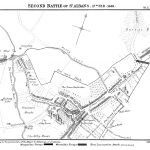The Second Battle of St Albans was fought on 17th February 1461. Richard Neville led a large Yorkist army in the defence of the town. Queen Margaret’s army marched south quickly after the Battle of Wakefield. Neville, Earl of Warwick, was caught by surprise. Led by Trollope, the Lancastrians flanked his positions and the town was taken after vicious hand to hand combat in the streets. The main Yorkist army was unable to support the town. A retreat to London was ordered by the Earl of Warwick, leaving the Lancastrians victorious. The Battle took part in an unusually busy winter campaign of the Wars of the Roses.
Build up to the Second Battle of St Albans
Richard of York had been killed in the Battle of Wakefield. Queen Margaret now marched south. The King was held captive in London. Her army was bolstered by mercenaries from Scotland. The Lancastrian Army wore the insignia of the Prince of Wales. On route south the Lancastrians sacked the towns of Grantham and Stamford. Yorkists used this for propaganda purposes. The Army from the north were savages, intent of looting towns. News of these attacks scared many in the south. It made them more supportive of the Yorkist cause.
Richard Neville, Earl of Warwick, commanded Yorkist troops near London. Contemporary estimates of the size of his army are probably exaggerated. The Abbott of St. Albans suggests 25000. William Gregory, who was in the Yorkist army, says it was 100000 strong. Other nobles had joined Warwick’s army. In earlier battles the Yorkist force had been limited to mainly the Duke of York, his family and that of the Neville family.
As the Queens army marched south, Warwick prepared to meet them. It was important to the Yorkists to try and stop the Queen from capturing London and freeing the king. Warwick and his brother marched their army to St. Albans.
Defending St Albans
St. Albans was turned into a highly defended fortified position. Warwick had artillery and handguns. Wires and caltrops were placed around the town. The Yorkist force was large and had reinforcements positioned outside of the town to counter any Lancastrian successes. Queen Margaret’s army had marched quickly, in wintery conditions. Many of the Scots had now deserted and gone home. It appeared that the Yorkists, with their unbeaten commander Richard Neville, were certain to win.
The Second Battle of St. Albans began in the night. Andrew Trollope used the cover of darkness to lead a Lancastrian force around the edge of the town. With most of the defences facing northwards, he had outflanked Neville’s position. Yorkist archers held back the Lancastrian attack. They could not sustain this for long though. Pushed back the archers and infantry stationed in the town had to engage in a desperate hand to hand battle with the Lancastrians. Neville’s defensive lines prevented his main army, north of the town, from going to the rescue.
As it became clear that the Lancastrians had won the town centre, Warwick realised that the battle was lost. His force had been divided, some had changed sides as well, and the town and it’s defences had been taken by the Lancastrians. To make things worse for Warwick, his artillery failed to fire. The winter conditions causing the cannon and handguns to fail. With little hope of victory, Warwick retreated south to London.
Consequences of the Second Battle of St Albans
The Second Battle of St. Albans was won by the Lancastrians. It gave them an advantage that they failed to press home. Instead of building on this success and marching on London, they retired to the north. They had rescued the king from Yorkist control. The Prince of Wales was knighted on the battlefield: he was aged 7, it was entirely for ceremony.
Bizarrely the Prince of Wales was then placed as Judge in the trial of the two Yorkists who had stayed at Henry VI’s side to ensure his safety. Despite Henry promising clemency, the 7 year old Prince of Wales found them guilty and sentenced them to death. Both of the men were aged around 70, the sentence of hanging was carried out straight away. The likelihood is that Queen Margaret orchestrated this show trial. One of the men was a Bonville and Margaret had supported that families opponents, the Courtenays, in a feud over land.
The first clash between Yorkist and Lancastrian factions also took place in St. Albans. The First Battle of St. Albans was in 1455. It led to a period of Yorkist dominance in court.
Causes of the Wars of the Roses – Course of the War of the Roses – Events of the War of the Roses
Battles in the Wars of the Roses
First Battle of St. Albans – Battle of Blore Heath – Battle of Ludford Bridge – Battle of Northampton – Battle of Wakefield – Battle of Mortimer’s Cross – Second Battle of St. Albans Battle of Ferrybridge – Battle of Towton – Battle of Hedgeley Moor – Battle of Hexham – Battle of Edgecote Moor – Battle of Losecote Field – Battle of Barnet – Battle of Tewkesbury – Battle of Bosworth – Battle of Stoke Field
Documents, Maps and Evidence
The Rous Rolls – Paston Letters – Edward IV Roll
People and periods
British History – The Wars of the Roses – The Plantagenets – The Tudors – King Henry IV – King Henry V – King Henry VI – King Edward IV – King Edward V – King Richard III – King Henry VII – Margaret of Anjou
Schoolshistory – teaching resources for Key Stage 3, GCSE and A Level history


